《DSP using MATLAB》Problem 3.3

按照题目的意思需要利用DTFT的性质,得到序列的DTFT结果(公式表示),本人数学功底太差,就不写了,直接用
书中的方法计算并画图。
代码:
%% ------------------------------------------------------------------------
%% Output Info about this m-file
fprintf('\n***********************************************************\n');
fprintf(' <DSP using MATLAB> Problem 3.3 \n\n'); banner();
%% ------------------------------------------------------------------------ % ----------------------------------
% x1(n)
% ----------------------------------
n1_start = -3; n1_end = 13;
n1 = [n1_start : n1_end]; x1 = (2 * 0.5.^ (n1)) .* stepseq(-2, n1_start, n1_end); figure('NumberTitle', 'off', 'Name', 'Problem 3.3 x1(n)');
set(gcf,'Color','white');
stem(n1, x1);
xlabel('n'); ylabel('x1');
title('x1(n) sequence'); grid on; M = 500;
k = [-M:M]; % [-pi, pi]
%k = [0:M]; % [0, pi]
w = (pi/M) * k; [X1] = dtft(x1, n1, w); magX1 = abs(X1); angX1 = angle(X1); realX1 = real(X1); imagX1 = imag(X1); figure('NumberTitle', 'off', 'Name', 'Problem 3.3 DTFT of x1(n)');;
set(gcf,'Color','white');
subplot(2,1,1); plot(w/pi, magX1); grid on;
title('Magnitude Part');
xlabel('frequency in \pi units'); ylabel('Magnitude');
subplot(2,1,2); plot(w/pi, angX1); grid on;
title('Angle Part');
xlabel('frequency in \pi units'); ylabel('Radians'); X1_chk = 8*exp(j*2*w) + 4*exp(j*w) + 2 ./ (1-0.5*exp(-j*w));
magX1_chk = abs(X1_chk); angX1_chk = angle(X1_chk); realX1_chk = real(X1_chk); imagX1_chk = imag(X1_chk); figure('NumberTitle', 'off', 'Name', 'Problem 3.3 X1(w) by formular');;
set(gcf,'Color','white');
subplot(2,1,1); plot(w/pi, magX1_chk); grid on;
title('Magnitude Part');
xlabel('frequency in \pi units'); ylabel('Magnitude');
subplot(2,1,2); plot(w/pi, angX1_chk); grid on;
title('Angle Part');
xlabel('frequency in \pi units'); ylabel('Radians'); % -------------------------------------
% x2(n)
% -------------------------------------
n2_start = -9; n2_end = 15;
n2 = [n2_start : n2_end]; x2 = (0.6 .^ (abs(n2))) .* (stepseq(-10, n2_start, n2_end) - stepseq(11, n2_start, n2_end)); figure('NumberTitle', 'off', 'Name', 'Problem 3.3 x2(n)');
set(gcf,'Color','white');
stem(n2, x2);
xlabel('n'); ylabel('x2');
title('x2(n) sequence'); grid on; M = 500;
k = [-M:M]; % [-pi, pi]
%k = [0:M]; % [0, pi]
w = (pi/M) * k; [X2] = dtft(x2, n2, w); magX2 = abs(X2); angX2 = angle(X2); realX2 = real(X2); imagX2 = imag(X2); figure('NumberTitle', 'off', 'Name', 'Problem 3.3 DTFT of x2(n)');;
set(gcf,'Color','white');
subplot(2,1,1); plot(w/pi, magX2); grid on;
title('Magnitude Part');
xlabel('frequency in \pi units'); ylabel('Magnitude');
subplot(2,1,2); plot(w/pi, angX2); grid on;
title('Angle Part');
xlabel('frequency in \pi units'); ylabel('Radians'); % -------------------------------------
% x3(n)
% -------------------------------------
n3_start = -3; n3_end = 10;
n3 = [n3_start : n3_end]; x3 = ( n3 .* (0.9 .^ (n3))) .* stepseq(-3, n3_start, n3_end); figure('NumberTitle', 'off', 'Name', 'Problem 3.3 x3(n)');
set(gcf,'Color','white');
stem(n3, x3);
xlabel('n'); ylabel('x3');
title('x3(n) sequence'); grid on; M = 500;
k = [-M:M]; % [-pi, pi]
%k = [0:M]; % [0, pi]
w = (pi/M) * k; [X3] = dtft(x3, n3, w); magX3 = abs(X3); angX3 = angle(X3); realX3= real(X3); imagX3 = imag(X3); figure('NumberTitle', 'off', 'Name', 'Problem 3.3 DTFT of x3(n)');;
set(gcf,'Color','white');
subplot(2,1,1); plot(w/pi, magX3); grid on;
title('Magnitude Part');
xlabel('frequency in \pi units'); ylabel('Magnitude');
subplot(2,1,2); plot(w/pi, angX3); grid on;
title('Angle Part');
xlabel('frequency in \pi units'); ylabel('Radians'); % -------------------------------------
% x4(n)
% -------------------------------------
n4_start = 0; n4_end = 50;
n4 = [n4_start : n4_end]; x4 = (n4 + 3) .* (0.8 .^ (n4-1)) .* stepseq(2, n4_start, n4_end); figure('NumberTitle', 'off', 'Name', 'Problem 3.3 x4(n)');
set(gcf,'Color','white');
stem(n4, x4, 'r', 'filled');
xlabel('n'); ylabel('x4');
title('x4(n) sequence'); grid on; M = 500;
k = [-M:M]; % [-pi, pi]
%k = [0:M]; % [0, pi]
w = (pi/M) * k; [X4] = dtft(x4, n4, w); magX4 = abs(X4); angX4 = angle(X4); realX4= real(X4); imagX4 = imag(X4); figure('NumberTitle', 'off', 'Name', 'Problem 3.3 DTFT of x4(n)');;
set(gcf,'Color','white');
subplot(2,1,1); plot(w/pi, magX4); grid on;
title('Magnitude Part');
xlabel('frequency in \pi units'); ylabel('Magnitude');
subplot(2,1,2); plot(w/pi, angX4); grid on;
title('Angle Part');
xlabel('frequency in \pi units'); ylabel('Radians'); % -------------------------------------
% x5(n)
% -------------------------------------
n5_start = 0; n5_end = 30;
n5 = [n5_start : n5_end]; x5 = 4 * (-7 .^ (n5)) .* cos(0.25*pi*n5) .* stepseq(0, n5_start, n5_end); figure('NumberTitle', 'off', 'Name', 'Problem 3.3 x5(n)');
set(gcf,'Color','white');
stem(n5, x5, 'r', 'filled');
xlabel('n'); ylabel('x5');
title('x5(n) sequence'); grid on; M = 500;
k = [-M:M]; % [-pi, pi]
%k = [0:M]; % [0, pi]
w = (pi/M) * k; [X5] = dtft(x5, n5, w); magX5 = abs(X5); angX5 = angle(X5); realX5= real(X5); imagX5 = imag(X5); figure('NumberTitle', 'off', 'Name', 'Problem 3.3 DTFT of x5(n)');
set(gcf,'Color','white');
subplot(2,1,1); plot(w/pi, magX5); grid on;
title('Magnitude Part');
xlabel('frequency in \pi units'); ylabel('Magnitude');
subplot(2,1,2); plot(w/pi, angX5); grid on;
title('Angle Part');
xlabel('frequency in \pi units'); ylabel('Radians');
运行结果:
1、原始序列及其DTFT
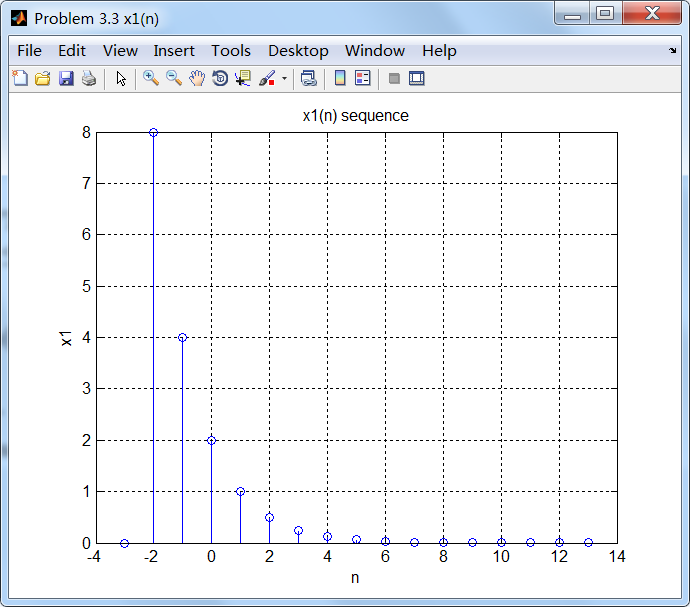
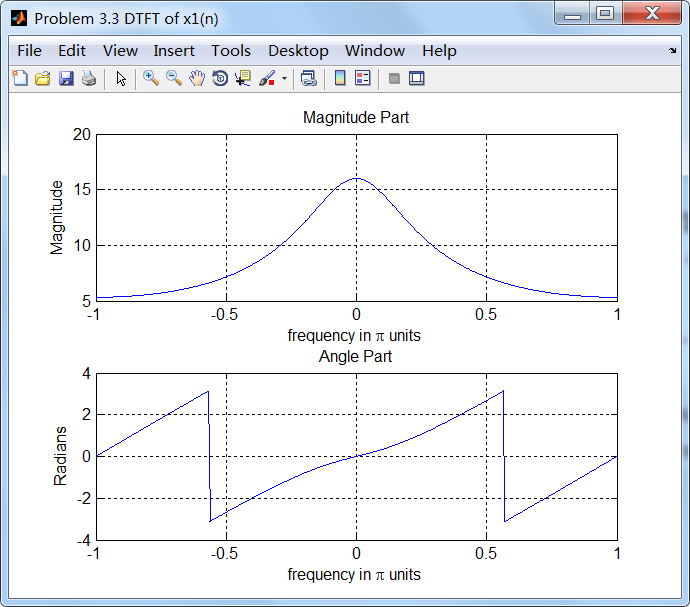
2、
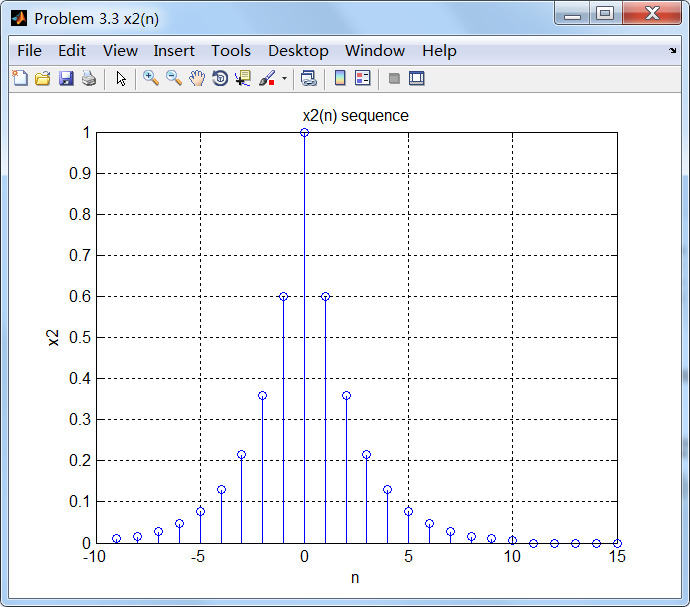
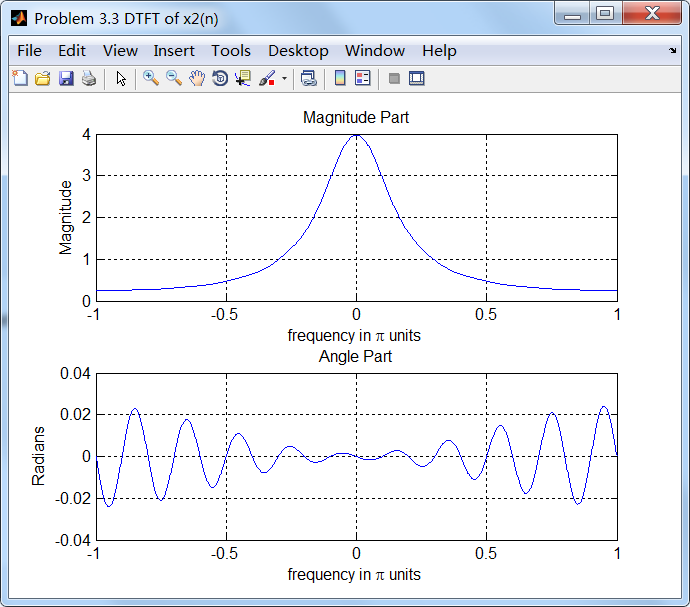
3、
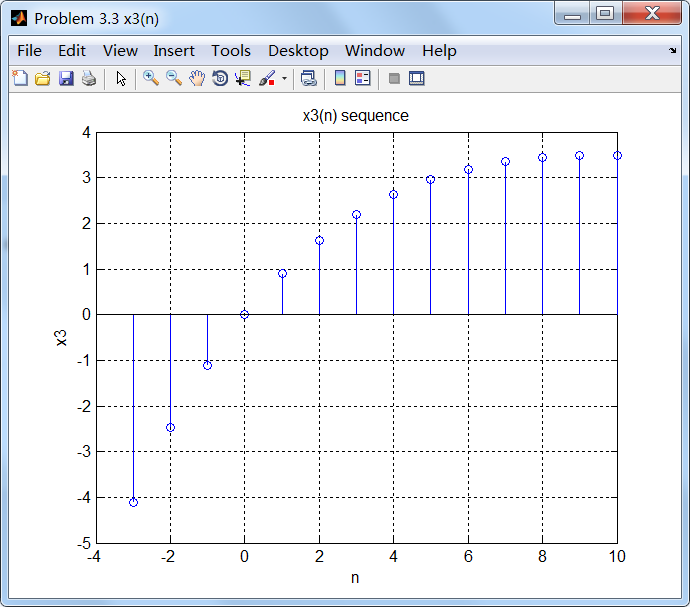
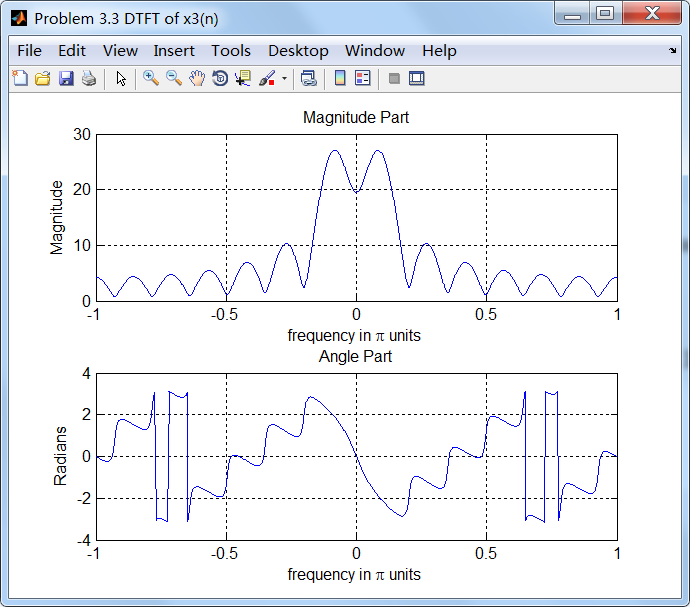
4、
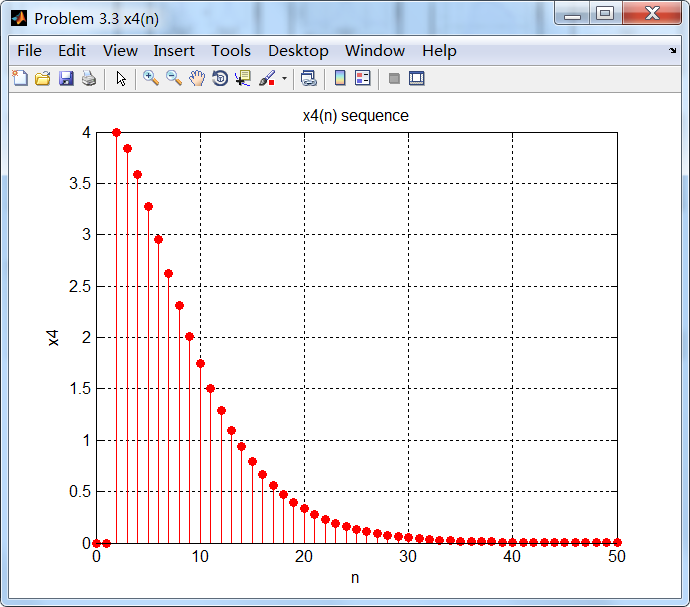
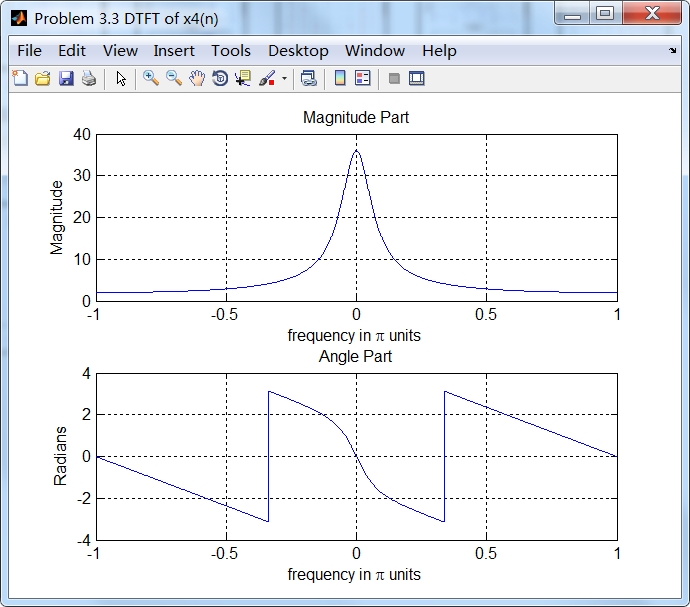
5、
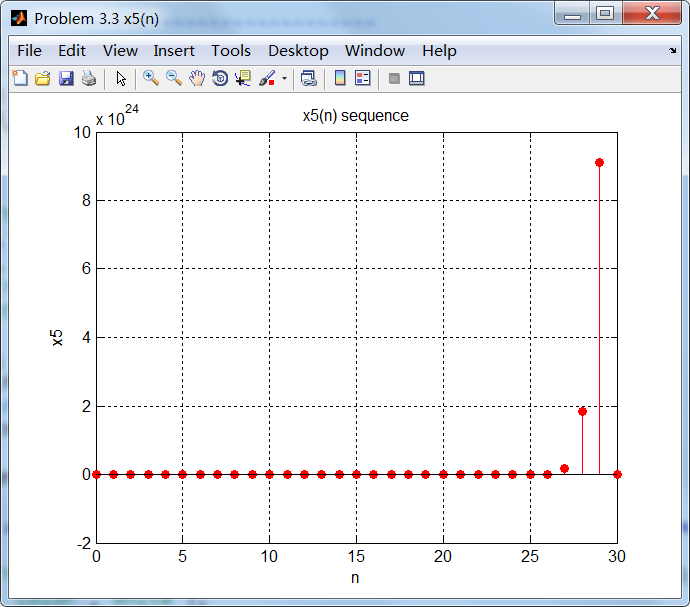

《DSP using MATLAB》Problem 3.3的更多相关文章
- 《DSP using MATLAB》Problem 7.27
代码: %% ++++++++++++++++++++++++++++++++++++++++++++++++++++++++++++++++++++++++++++++++ %% Output In ...
- 《DSP using MATLAB》Problem 7.26
注意:高通的线性相位FIR滤波器,不能是第2类,所以其长度必须为奇数.这里取M=31,过渡带里采样值抄书上的. 代码: %% +++++++++++++++++++++++++++++++++++++ ...
- 《DSP using MATLAB》Problem 7.25
代码: %% ++++++++++++++++++++++++++++++++++++++++++++++++++++++++++++++++++++++++++++++++ %% Output In ...
- 《DSP using MATLAB》Problem 7.24
又到清明时节,…… 注意:带阻滤波器不能用第2类线性相位滤波器实现,我们采用第1类,长度为基数,选M=61 代码: %% +++++++++++++++++++++++++++++++++++++++ ...
- 《DSP using MATLAB》Problem 7.23
%% ++++++++++++++++++++++++++++++++++++++++++++++++++++++++++++++++++++++++++++++++ %% Output Info a ...
- 《DSP using MATLAB》Problem 7.16
使用一种固定窗函数法设计带通滤波器. 代码: %% ++++++++++++++++++++++++++++++++++++++++++++++++++++++++++++++++++++++++++ ...
- 《DSP using MATLAB》Problem 7.15
用Kaiser窗方法设计一个台阶状滤波器. 代码: %% +++++++++++++++++++++++++++++++++++++++++++++++++++++++++++++++++++++++ ...
- 《DSP using MATLAB》Problem 7.14
代码: %% ++++++++++++++++++++++++++++++++++++++++++++++++++++++++++++++++++++++++++++++++ %% Output In ...
- 《DSP using MATLAB》Problem 7.13
代码: %% ++++++++++++++++++++++++++++++++++++++++++++++++++++++++++++++++++++++++++++++++ %% Output In ...
- 《DSP using MATLAB》Problem 7.12
阻带衰减50dB,我们选Hamming窗 代码: %% ++++++++++++++++++++++++++++++++++++++++++++++++++++++++++++++++++++++++ ...
随机推荐
- qml学习笔记(二):可视化元素基类Item详解(上半场anchors等等)
原博主博客地址:http://blog.csdn.net/qq21497936本文章博客地址:http://blog.csdn.net/qq21497936/article/details/78516 ...
- 远程连接软件TeamViewer
(1)先在windows下安装Teamviewer软件,地址:https://pan.baidu.com/s/1rWxRBtNbn3OMmg-8YaYWRQ (2)再在linux下安装Teamview ...
- iframe 跨域问题解决方案 利用window.name+iframe跨域获取数据详解
详解 前文提到用jsonp的方式来跨域获取数据,本文为大家介绍下如何利用window.name+iframe跨域获取数据. 首先我们要简单了解下window.name和iframe的相关知识.ifra ...
- 【知识总结】CSS中样式覆盖优先顺序
层叠样式类型 类型: 1. 浏览器默认样式 2. 浏览器用户自定义样式 3. 外部样式表 4. 内部样式表 5. 内联样式表 顺序: 浏览器默认样式 < 浏览器用户自定义样式 < 外部样式 ...
- 能否通过六面照片构建3D模型?比如人脸,全身的多角度照片,生成3D模型。?
https://www.zhihu.com/question/36412840 9023 添加评论 分享 邀请回答举报 收起 已关注写回答 9 个回答 默认排序 叛逆者 计算机图形学 ...
- 337BRoutine Problem
/*给出你图片的长和宽的比例a:b 和摄像头的比例c:d,然后叫你求最后将图片放进摄像头 以后,剩余的面积比上摄像头的总面积,注意要化简为最简形式,而且摄像头要设置成至少一条边和图片相等 做法:先将两 ...
- 利用ansible进行自动化构建etcd集群
上一篇进行了手动安装etcd集群,此篇利用自动化工具ansible为三个节点构建etcd集群 环境: master:192.168.101.14,node1:192.168.101.15,node2: ...
- HDU 3709 Balanced Number(数位DP)题解
思路: 之前想直接开左右两边的数结果爆内存... 枚举每次pivot的位置,然后数位DP,如果sum<0返回0,因为已经小于零说明已经到了pivot右边,继续dfs只会越来越小,且dp数组会炸 ...
- Codeforces Round #402 (Div. 2) A,B,C,D,E
A. Pupils Redistribution time limit per test 1 second memory limit per test 256 megabytes input stan ...
- hdu 5701 中位数计数 思路题
中位数计数 Time Limit: 12000/6000 MS (Java/Others) Memory Limit: 65536/65536 K (Java/Others)Total Subm ...
